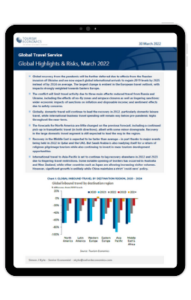Travel and Tourism: Global Highlights & Risks

Global recovery from the pandemic will be further deferred due to effects from the Russian invasion of Ukraine and we now expect global international arrivals to regain 2019 levels by 2025 instead of by 2024 on average. The largest change is evident in the European travel outlook, with impacts strongly weighted towards Eastern Europe. The conflict will limit travel activity due to three main effects: reduced travel from Russia and Ukraine, including the effects of no-fly zones and airspace closures as well as lingering sanctions; wider economic impacts of sanctions on inflation and disposable income; and sentiment effects due to safety concerns.
What you will learn:
- Globally, domestic travel will continue to lead the recovery in 2022, particularly domestic leisure travel, while international business travel spending will remain way below pre-pandemic highs throughout the near-term.
- The forecasts for North America are little changed on the previous forecast, including a continued pick-up in transatlantic travel (in both directions), albeit with some minor downgrade.
- Recovery in the Middle East is expected to be faster than average – in part thanks to major events being held in 2022 in Qatar and the UAE.
Tags:
Related Services

Post
Food prices to bottom out in 2024, risks skewed to upside
Our baseline forecast is for world food commodity prices to register an annual decline this year, in aggregate, reducing pressure on food retail prices further downstream. However, we believe the risks to this forecast are overwhelmingly skewed to the upside.
Find Out More
Post
Battery raw material prices to recover
Battery raw materials prices bottomed out last quarter and we think a sustained recovery is looming. Midstream EV battery manufacturing activity has picked up again and inventories have returned to historical levels, suggesting upstream demand for raw materials will also bounce back.
Find Out More